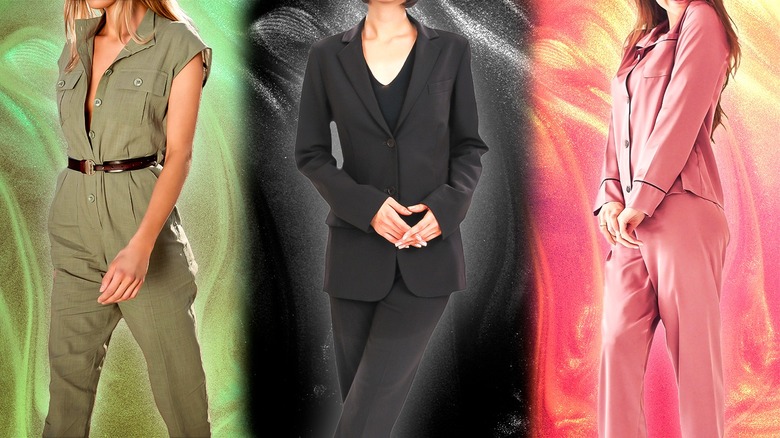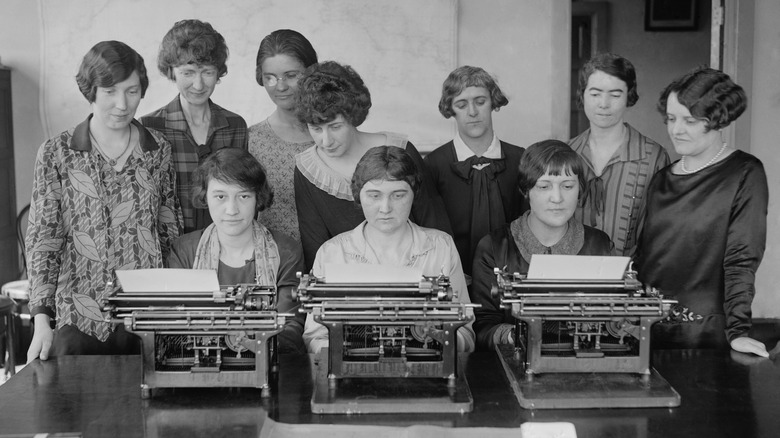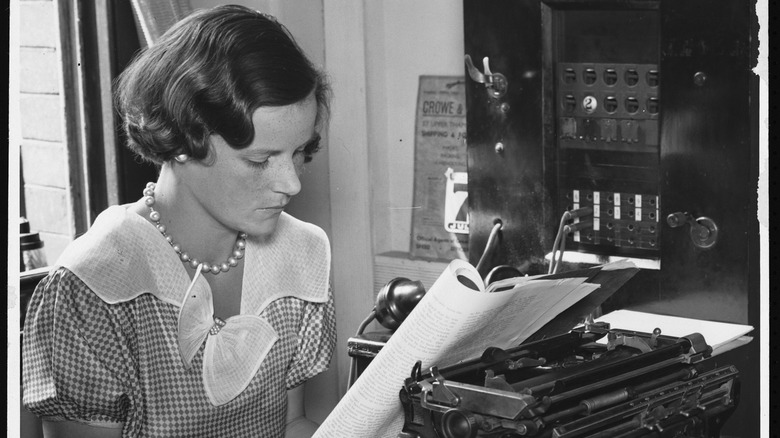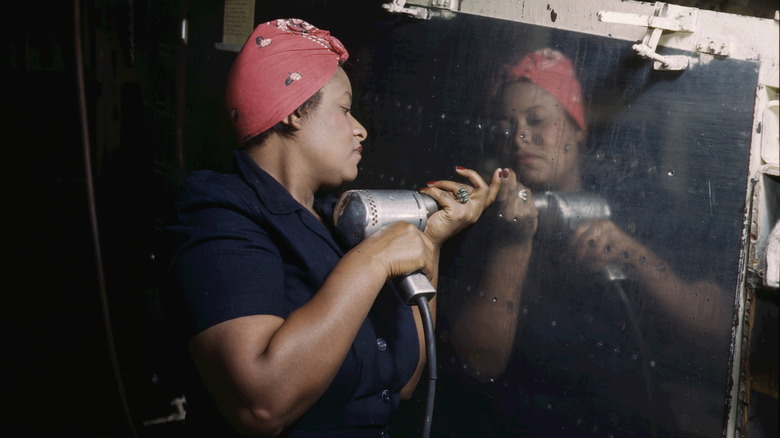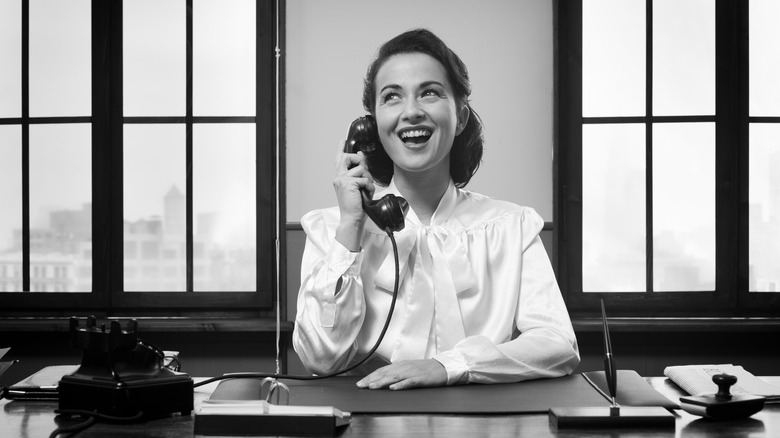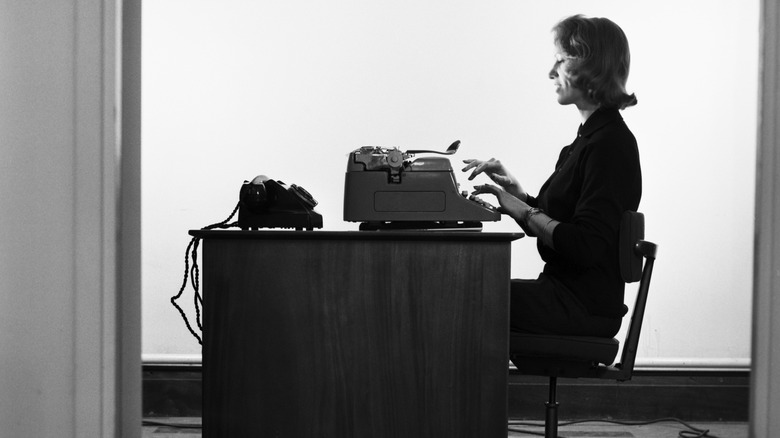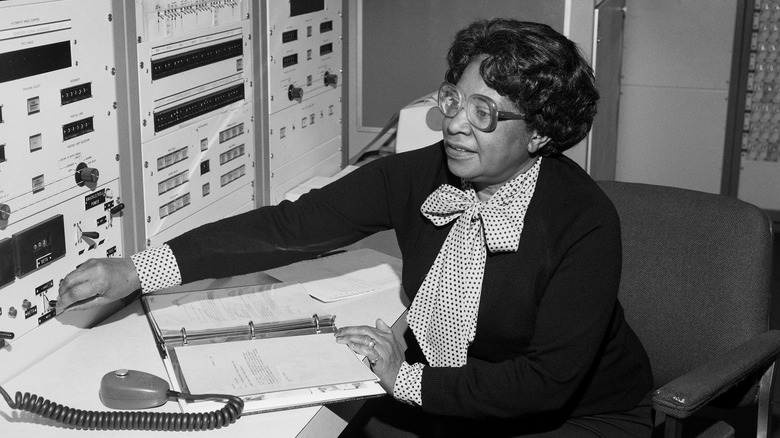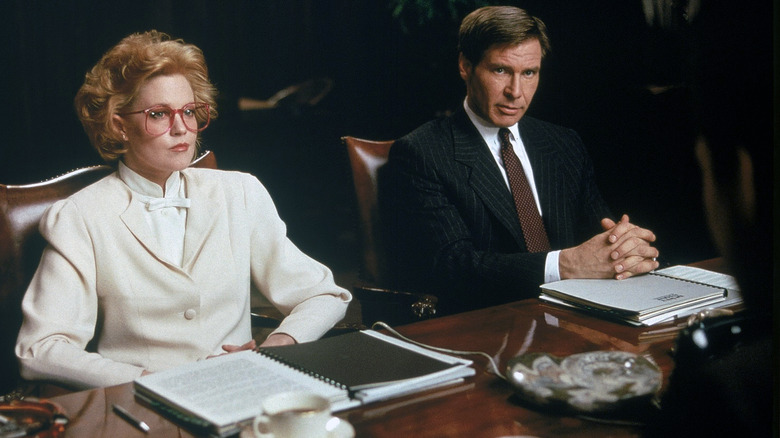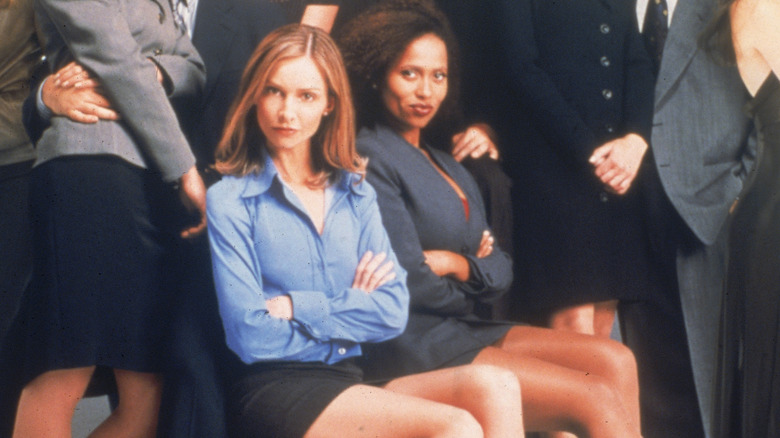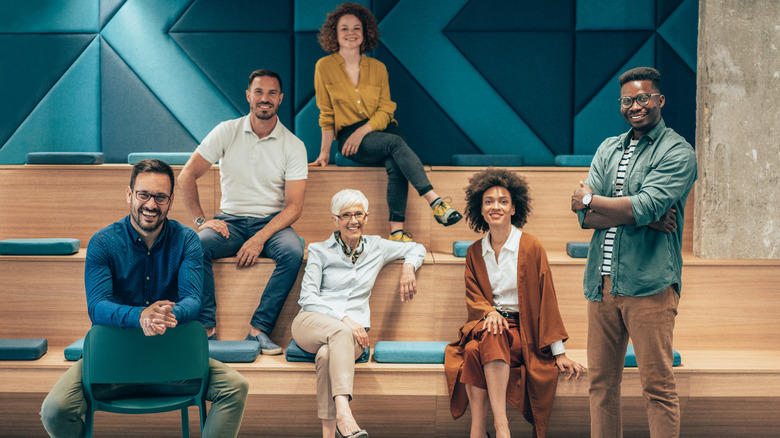100 Years Of Fashion: Workwear
The history of women in the workplace is a long and varied one; women have always worked outside of the home, of course, and quite a bit can be determined by the clothes they have traditionally worn while doing so. Dressing for work is traditionally a different situation than, say, dressing for a night out or a day at the beach. The expectation is that work clothes make one look professional — skilled, confident, capable, and appropriate to the workplace environment. It might be a service uniform, a structured skirt or pantsuit, or a collection of separates that vary in terms of formality and style depending on one's industry.
It has often been a challenge to maintain one's individual sense of style at work. Furthermore, the societal expectations concerning women's appearances has varied wildly over the last century. Restrictive clothing and uncomfortable shoes, as well as the controversy over the appropriateness of pants for professional women that went on for far longer than you might imagine has made workwear a constantly changing and evolving concern. And as you'll see, its history is complicated and fascinating.
1920 - 1929: Corsets are out, individuality is in
The 1920s brought all sorts of new freedoms to a large number of American women. The 19th amendment, ratified in 1920, gave women the right to vote for the first time; that same year, 21% of American women worked outside of the home. As noted by the BBC, it was during this decade that corsets fell out of favor as undergarments, giving women a literal freedom of movement they hadn't had in the past, along with looser, dropped waistlines. This certainly made all sorts of labor, paid and otherwise, more comfortable and possible to perform for longer periods of time.
Many women who worked outside the home during this time period did domestic work in private homes or worked in factories. These jobs often involved wearing uniforms, which would cut down on the amount of personal style one could inject into workwear. However, Helen McCarthy, lecturer in early modern history at Cambridge University, notes that factory workers would wear favorite blouses or stockings under their coveralls or aprons. "[W]omen find ways to express their personality, to assert themselves, even though their position in the labor force is a subordinate one," says McCarthy to BBC, noting colorful headscarves or bootlaces were other ways to incorporate personal style into restrictive dress codes.
1930 - 1939: Workwear reflects the trends of the day
The 1930s ushered in the Great Depression in the United States, which according to the History Channel saw the number of working women rise 24% from 10.5 million to 13 million over the course of the decade. Historian Susan Ware explains: "Women were more insulated from job loss because they were employed in more stable industries like domestic service, teaching, and clerical work." For those working in office or in retail, "Simple, neat dresses, or separates, were deemed appropriate ... Clothes for work reflected contemporary fashions because working women tended to be young and expected to leave employment on getting married," says fashion historian Amber Butchart in Harper's Bazaar.
French designer Marcel Rochas created what is thought to be the first pantsuit in 1932, and while the pantsuit would become a future staple of women's workwear, pants were still considered too informal for most workplaces. Actor Katharine Hepburn became known for her love of pants, which was still considered unusual enough that her studio reportedly asked her not to wear them on sets because it caused too much attention from shocked photographers. Aviator Amelia Earhart was often photographed wearing pants, as they were the most practical clothing option when flying an airplane. She even designed a line of clothing for "active women," per the Smithsonian, including a two-piece flying suit intended for the Ninety-Nines, a society of female aviators of which she was president.
1940 - 1949: Rosie the Riveter and other women at work
The end of the 1930s saw the beginning of World War II, with the United States entering the conflict after the attack on Pearl Harbor on December 7, 1941. Per History, in 1940, 15% of married women and 50% of single women worked for wages. As men joined the armed forces in droves, more women than ever before began working outside their homes, many of them taking on traditionally masculine jobs in machine shops and other factories. The National Bureau of Economic Research notes that the 1940s saw the largest proportional increase in female labor during the entire 20th century.
The famous "Rosie The Riveter" campaign started in 1943 by the Westinghouse Electric Corporation featured a worker in a red headscarf to protect and keep her hair out of her way, and blue workshirt. The iconic image featured her flexing her bicep under the slogan "We can do it!" As evidenced by many actual photographs of working women from this time period, the practical look was a common one. As seen in the photo above, women continued personalizing their workwear, as did this unidentified worker with her glamorous ring and red nails. Meanwhile, outside of factories, it was still rare to see working women in pants. For example, women in all branches of the armed forces as well as those who worked as nurses all wore uniforms that featured skirts — the uniforms were designed to mimic civilian clothing and be appealing to women.
1950 - 1959: Keeping it ladylike, in and out of the office
In 1950, 43.9% of women ages 16 to 24 had paying jobs, and across the decade, one out of three American women worked outside the home, according to the Bureau of Labor Statistics. This era saw the United States undertake a national agenda focused on marriage and family; marrying rates were at an all-time high, and people married at young ages. Women were encouraged to stop working after marrying and stay home with their children if they could afford to do so. Common jobs held by women included teacher, nurse, stewardess, librarian, secretary, and factory worker, per the National Archives. Once again, workwear tended to reflect fashion trends in general, which skewed extremely feminine and stereotypically "ladylike" with skirt suits featuring nipped-in waists and wide or fitted skirts, and shorter sleeves to better highlight gloves and bracelets.
Soubrette Vintage notes that one proponent of what has come to be recognized as a classic 1950s look for working women was designer Kay Windsor, who created the line Private Secretary in tandem with the television show of the same name, which featured actress Ann Southern as the — yes — private secretary to a talent agent. The ads promised to "keep you smartly groomed through your business day right into an evening of date-time glamour." A similar look would later be seen on the character of secretary-turned-copywriter Peggy Olson in the first season of the television show "Mad Men," which takes place in 1960.
1960 - 1969: Skirt suits take over everywhere
One of the more iconic looks of the 1960s is that of the boxy tweed suit, as popularized by First Lady Jacqueline Kennedy in her signature pink Chanel. Per The Women's Network, the look featured shorter skirts than those seen in the 1950s, with the suits offering a professional, put together look that translated well to office wear. The number of women in the workforce continued increasing. In 1960, 38% of American women worked outside the home; by 1965, the rate had risen to 42%. History Central credits the availability of birth control pills starting in 1960, as well as the rise of second-wave feminism. Betty Friedan's "The Feminine Mystique" was published in 1962 and invited women to "break out of the household trap and truly find fulfillment as wives and mothers — by fulfilling their own unique possibilities as separate human beings."
In an interview with The Atlantic, Lola Cherson, who worked in advertising in the 1960s, told reporter Jen Doll, "Back then we wore nice dresses. [T]he biggest inconvenience were the seams in the stockings, making sure they were straight. We thought pantyhose was the greatest invention." Pants were still generally frowned upon. In an interview for an oral history of the British post office, held by the British Library, former telecommunications manager Morag Simpson MacDonald, who started her job in 1969, recalled: "Women were allowed to wear trousers to work providing they asked everybody else who worked in their office if they minded or not."
1970 - 1979: How should a working woman dress?
In the 1970s, women entered the workforce like never before. In 1970, 43% of women aged 16 and over worked outside the home, per the Population Reference Bureau. There was now an expectation among younger women that they would spend a good portion of their lives working, and many started preparing to do so via college and other training opportunities. Despite, or perhaps because of, the increase of women in the workplace, workwear remained a controversial subject. Pantsuits were more common, often featuring stylish bellbottoms, but it was still an expectation that skirts were more appropriate for womenswear regardless of practicality or comfort. In the 1977 book "The Women's Dress for Success Book," author John Molloy wrote: "My research indicates that a three-piece pinstripe suit not only does not add to a woman's authority, it destroys it. It makes her look like an 'imitation man.'" Unsurprisingly, Molloy recommended skirt suits for working women.
The "pussy bow" blouse, first seen in the 1930s, became a workwear staple for women in the 1970s, as seen above on Mary Jackson, the first Black woman engineer at NASA. In the documentary "Makers: Women Who Make America," Hewlett-Packard CEO Meg Whitman remembered, "We used to dress in suits with a skirt and a jacket with button-down shirts and a little bow tie, because that was sort of our interpretation of the man's tie. It was our attempt to be feminine but fit into what was then a male world" (via Mic).
1980 - 1989: Big business, big hair, big shoulders
By 1980, 52% of American women were working outside of the home, according to the Bureau of Labor Statistics. Working women became a pop culture staple in movies like "Baby Boom," "Working Girl," and "Nine to Five," and television shows like "Murphy Brown" and "Designing Women." Women's workwear, like so many things in the 1980s, got bigger and brighter — suits had big shoulder pads and were often brightly colored and worn with large jewelry. As always, there was a political aspect to these kinds of outfits, as they allowed women to physically take up more space and assert themselves among men, as their office wear suddenly had more similarities than differences. "It was like, 'Look at this, I can do the job you can do, and so I'll dress like you do,'" Ann Taylor creative director Austyn Zung told The Cut.
Alongside power suit dressing was an interest in separates that could not only be mixed and matched but also worn from a day at work to an evening out. Designer Donna Karan debuted her Seven Easy Pieces collection in 1985, noting that many women found clothes "bewildering," and said, "They've discovered fast ways to put food on the table, but they do not know how to get their wardrobes together easily" (via InStyle). This early example of today's trendy "capsule wardrobe" included a bodysuit, a skirt, a pair of loose trousers, a tailored jacket, a cashmere sweater, a white shirt, and a large scarf to accessorize as needed.
1990 - 1999: Short skirts and casual Fridays
The fashions of the 1990s tended to skew toward neutral and muted colors and minimalist styling, and workwear was no different. Suiting for women featured more body-conscious cuts than the boxy silhouettes from the previous decade, and hemlines rose. The television show "Ally McBeal," featuring a group of young Boston lawyers, got attention for the wardrobe of its star Calista Flockhart, shown above with co-star Lisa Nicole Carson, which often featured micro miniskirts peeking out from the bottom of long jackets. Costumer Juliet Hyde-White told Vogue that the skirts were meant "to show off Ally's great legs. There was nothing like that show ever ... so it had to catch the audience's attention." The article notes designers such as Alexander McQueen featured the look on runways as well, and Cake's 2001 song "Short Skirt/Long Jacket" paid homage to it with lyrics about a business-savvy woman wearing the titular outfit. Two years earlier, the percentage of American women working outside the home peaked at 60%.
Another important '90s workwear development for people of all genders was the rise of casual Fridays, which ushered in a general trend toward a more casual workplace, often termed "business casual." Per Levi Strauss & Co., the Dockers brand published a pamphlet in 1992 titled "Guide to Casual Business Wear" and sent it to 25,000 HR managers around the U.S. According to one survey, by 1995, nine out of 10 workplaces allowed employees to dress casually on an occasional or regular basis.
2000 - 2009: Smart casual takes over
The "seven easy pieces" that made Donna Karan famous in the 1980s and fully launched the idea of career separates had gone entirely mainstream by the 2000s. Office dress codes were overall more casual than ever, and women preferred to mix and match elements of their wardrobes rather than relying on suits. Furthermore, expectations for workwear tended to vary according to industry rather than gender. Traditional workplaces like law offices continued requiring formal, classic looks while more creative offices allowed for more casual outfits, as long as they skewed "smart" as opposed to sloppy. Executive coach Darlene Price told Business Insider that smart casual "fashionably combines elements from the other dress codes, such as a nice pair of dark slacks, with a coordinated dressy blouse, jacket, and scarf, or a nice pair of trousers with a button-down shirt and sport coat."
The smart casual look was such a '00s hit that it made its way into eveningwear as well. A 2017 BuzzFeed article noted that in looking at paparazzi pics from the 2000s, one sees that young celebrities of the day often favored tailored blouses, pashminas, natty vests, and fitted blazers. In 2007, Lily Allen wore a modest knee-length black sheath dress that caused writer Ailbhe Malone to quip that the pop star looked as if she had "been asked a particularly difficult interview question about Excel spreadsheet formulas."
2010 - 2019: Is casual workwear only for men?
By 2010, there were 72 million, or 58.6% of all American women, in the United States' workforce, per the Bureau of Labor Statistics. By then, the pantsuit was a traditional choice for working women after going mainstream in the 1990s. Its rise can perhaps be attributed in part to the Senate's "Pantsuit Rebellion of 1993" in which Maryland Senator Barbara Mikulski led other female senators in a mass pantsuit-wearing event on the Senate floor, which brought the rule barring women from wearing pants on said floor to an end. In the run-up to the 2016 presidential election, supporters of Democratic candidate Hillary Clinton formed a Facebook group called "Pantsuit Nation" in honor of the sartorial tendencies of Clinton, and several members wore pantsuits to vote.
On the opposite end of the spectrum, Big Tech workplaces ushered in an era of casual uniformity in which workers often dressed in sleek but nondescript jeans, black turtlenecks, and blazers, all the better to stay on one's grind in the quest to #girlboss. Minimalist capsule wardrobes were all the rage, particularly on social media; the "seven easy pieces" of the past remain an aspirational way to do workwear. Some point out that the hypercasual Big Tech look of jeans and sneakers, as made famous by Facebook founder Mark Zuckerberg, is really only available to men. A 2016 HuffPost article pointed out Facebook COO Sheryl Sandberg was usually dressed in typical corporate wear, with the addition of sky-high heels.
2020 - present: Is workwear still relevant?
When many offices switched to a work-from-home model at the onset of the pandemic in early 2020 (and working in yoga pants became the norm), the way that people think about and buy workwear likely changed forever. Recommendations for returning to the office have included such options as "power casual," which The New York Times noted is also known as "business comfort" and "workleisure." This includes lower heeled shoes, elasticized waists, and other kinds of "secret comfort" that prioritize ease alongside professionalism. Writer and diversity and inclusion expert Ritu Bhashin told The Washington Post, "Formal dress codes are an example of things that people don't want anymore," and explained that it benefits businesses to allow employees to express themselves via their workwear because "when we feel seen, when we feel connected to ourselves and others in work environments, we're more likely to show up, work harder, be more engaged."
Younger workers, many of whom have never worked in environments with strict or implicit dress codes, have made their own rules when it comes to what they wear to work, and it often trends toward a more formal version of pajamas. Yahoo! reports that Gen Z employees are "showing up in a relaxed fit of loungewear with the oversized shapes of streetwear," with plissé sets in flowy pleated fabrics are especially popular. Older employees may not always approve, but young workers are the future, and they have spoken: If we're at work, we're comfortable, and we're prioritizing self-expression.
